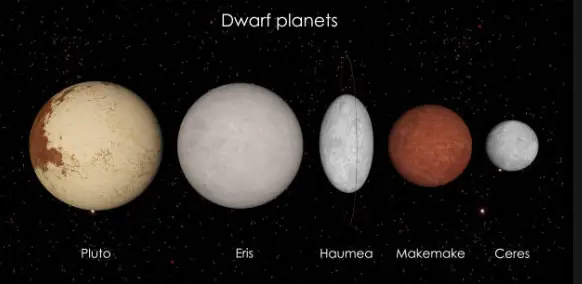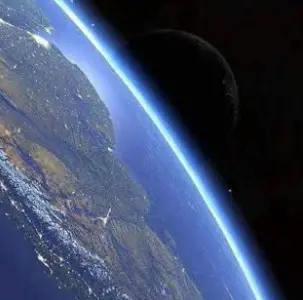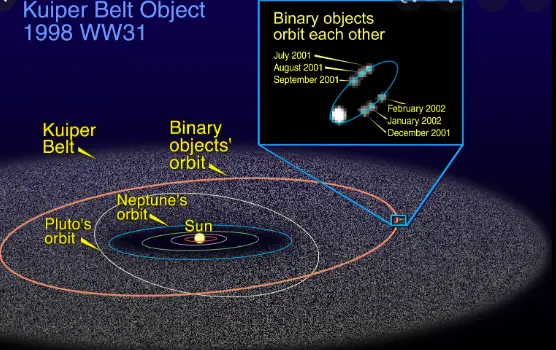INTERESTING FACTS ON DWARF PLANETS !!!
Dwarf planets are worlds that are too small to be considered full-fledged planets, but too large to fall into smaller categories.
The International Astronomical Union (IAU) decided the rules to what makes a planet. If they do not fit the three criteria the IAU uses, they are given the name of a dwarf planet.
The three criteria required to be called a planet by the IAU – Firstly, it has to orbit the Sun, secondly, its shape should resemble a ball like figure, and thirdly, it must be able to clear the area around its orbit, by pushing other objects out of its way with its impressive size and gravity.
Pluto was known as a planet up until 2006, but the International Astronomical Union decided because of its size, it did not have enough gravity to clear objects out of its way, so it was redefined as a dwarf planet.
There are officially five recognized dwarf planets in the Solar System : Ceres, Pluto, Haumea, Makemake and Eris.

The order of the dwarf planets closest from the Sun outwards: Ceres, Pluto, Haumea, Makemake and then Eris being the furthest from the Sun.
The orbit periods for the dwarf planets on their travels around the Sun: Ceres, 4.6 years, Pluto, 248 years, Haumea, 283.3 years, Makemake, 309.9 years and Eris, 560.9 years.
Haumea is one of the fastest spinning objects in the Solar System. A day on Haumea last just four hours. A day on Ceres is 9.1 hours, a day on Makemake is 22.5 hours, a day on Eris is 25.9 hours, while a day on Pluto is equal to 6.39 Earth days (about 153 hours).
Outside of the Solar System, there could be millions of dwarf planets similar to what is in it, but because of it’s vast distance, we just haven’t found them yet, even with the current technology available to us nowadays.
There are many more dwarf planets in the Solar System awaiting confirmation.
The Solar System consists of the Sun, and everything bound to it by gravity, including, planets and their moons, asteroids, dwarf planets, the Kuiper belt objects, meteoroids, comets and interplanetary dust.

Ceres is the closest dwarf planet to the Sun and lives in the Asteroid belt. It was discovered by astronomer Giuseppe Piazza in 1801.
Pluto is the second closest dwarf planet to the Sun and lives in the Kuiper Belt. It was discovered by astronomer Clyde W. Tombaugh in 1930.
Haumea is the third closest dwarf planet to the Sun and lives in the Kuiper Belt. It was discovered by a team of scientists in 2004.
Makemake is the fourth closest dwarf planet to the Sun and lives in the Kuiper Belt. It was discovered by a team of scientists in 2005.
Eris is the fifth closest dwarf planet to the Sun and lives in the Kuiper Belt. It was discovered by a team of scientists in 2005.
Pluto is just one of tens of thousands of frozen dwarf planets and asteroids in an area of the Solar System, called the Kuiper Belt.
The Asteroid Belt is a area of space between the orbits of Mars and Jupiter, where most of the asteroids in our Solar System are found orbiting the Sun. It most probably contain millions of asteroids.
The Kuiper Belt is one of the largest structures in our Solar System. Shaped like a donut, the Kuiper Belt stretches beyond the orbit of Neptune. It contains a vast region of icy objects, such as dwarf planets, short-period comets, rocks and ice.

The Kuiper Belt is about 25 times as wide as the Asteroid Belt.
Eris is the largest dwarf planet, measuring 1,445 miles (2,325 km) in diameter.
Ceres is the smallest dwarf planet, measuring 587 miles (944 km) in diameter. While it’s the smallest of the dwarf planets, it’s the largest object in the Asteroid Belt.
Eris has one moon, Dysnomia.
Pluto has five known moons, Charon, Styx, Nix, Kerberos and Hydra.
Haumea has two moons, Hi’iaka and Namaka.
Makemake has one provisional moon, nicknamed MK 2.
Ceres has no known moons.
Of all the dwarf planets, only 2 have been visited by space probes. In 2015, NASA’s Dawn and New Horizons missions reached Ceres and Pluto. By the time New Horizon reached Pluto, it had traveled more than 3 billion miles over nine years.





